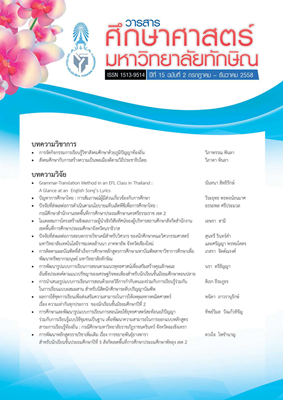ปัจจัยที่ส่งผลต่อการสอบตกรายวิชาเคมีสำหรับวิศวกร ของนักศึกษาคณะวิศวกรรมศาสตร์ มหาวิทยาลัยเทคโนโลยีราชมงคลล้านนา ภาคพายัพ จังหวัดเชียงใหม่
Main Article Content
บทคัดย่อ
บทคัดย่อ
การวิจัยครั้งนี้มีวัตถุประสงค์เพื่อ (1) เพื่อศึกษาการกระจายระดับขั้นการเรียนรู้ของนักศึกษาในกระบวนวิชาเคมีสำหรับวิศวกร ในภาคเรียนที่ 1 ปีการศึกษา 2553 (2) เพื่อศึกษาสาเหตุที่นักศึกษาสอบตกกระบวนวิชาเคมีสำหรับวิศวกร ในภาคเรียนที่ 1 ปีการศึกษา 2553
ประชากรของการวิจัยครั้งนี้ ได้แก่ นักศึกษาระดับปริญญาตรีที่ลงทะเบียนเรียนในกระบวนวิชา เคมีสำหรับวิศวกร (Chemistry for Engineers) รหัส 13020121 ในภาคเรียนที่ 1 ปีการศึกษา 2553 จำนวน 5 กลุ่ม จำนวนทั้งสิ้น 161 คน ได้แก่ สาขาวิชา คือ วิศวกรรมโยธา 4 ปี ชั้นปี 1 วิศวกรรมโยธา 4 ปี ชั้นปี 2 วิศวกรรมไฟฟ้า-ไฟฟ้ากำลัง 4 ปี ชั้นปี 1 วิศวกรรมไฟฟ้า-ไฟฟ้ากำลัง สมทบ 4 ปี ชั้นปี 1 และวิศวกรรมสิ่งแวดล้อม 4 ปี ชั้นปี 1 เครื่องมือที่ใช้ในการวิจัยประกอบด้วย (1) ใบระดับคะแนนวิชาเคมีสำหรับวิศวกร (2) แบบสอบถามสาเหตุที่นักศึกษาสอบตกวิชาเคมีสำหรับวิศวกร
การวิเคราะห์ข้อมูล ระดับคะแนนและสาเหตุที่นักศึกษาสอบตกวิชาเคมีสำหรับวิศวกรด้วยสถิติร้อยละ ผลการวิจัยพบว่า
1. การกระจายระดับขั้นในกระบวนวิชาเคมีสำหรับวิศวกร รหัส 13020121 ในภาคเรียนที่ 1 ปีการศึกษา 2553 จำนวน 5 กลุ่ม อยู่ในระดับขั้น D – D+ มีจำนวนมากที่สุดจำนวน 72 คน คิดเป็นร้อยละ 44.72 รองลงมาคือระดับขั้น F เพราะสอบตกมีจำนวน 36 คน คิดเป็นร้อยละ 22.36 และระดับขั้น F เพราะขาดสอบจำนวน 2 คน คิดเป็นร้อยละ 1.24 ระดับขั้น C – C+ มีจำนวน 31 คน คิดเป็นร้อยละ 19.26 ระดับขั้น B – B+ มีจำนวน 17 คน คิดเป็นร้อยละ 10.56 และ ระดับขั้น A มีจำนวน 3 คน คิดเป็นร้อยละ 1.86
ร้อยละของการสอบตกเทียบกับจำนวนนักศึกษาที่ลงทะเบียนเรียนกระบวนวิชาเคมีสำหรับวิศวกรของสาขาวิชาวิศวกรรมไฟฟ้า-ไฟฟ้ากำลัง สมทบ 4 ปี ชั้นปี 1 มีอัตราการสอบตกสูงที่สุด คิดเป็นร้อยละ 51.43 รองลงมาคือสาขาวิชาวิศวกรรมโยธา 4 ปี ชั้นปี 1 คิดเป็นร้อยละ 26.32 วิศวกรรมสิ่งแวดล้อม 4 ปี ชั้นปี 1 คิดเป็นร้อยละ 11.11 วิศวกรรมโยธา 4 ปี ชั้นปี 2 คิดเป็นร้อยละ 9.38 และวิศวกรรมไฟฟ้า-ไฟฟ้ากำลัง 4 ปี ชั้นปี 1 คิดเป็นร้อยละ 5.00
2. สาเหตุของการสอบตกของนักศึกษาทั้ง 5 กลุ่มสาขาวิชาที่ลงทะเบียนเรียนในกระบวนวิชา เคมีสำหรับวิศวกร มีสาเหตุเกิดจาก (1) นักศึกษามีความรู้พื้นฐานวิชาวิทยาศาสตร์และคณิตศาสตร์ต่ำ (2) ทำกิจกรรมเสริมหลักสูตรมาก (3) ไม่มีเวลาพอที่จะทำการค้นคว้าหรือฝึกทำข้อสอบ เนื่องจากเนื้อหามาก และไม่สามารถนำทฤษฎี ตัวอย่าง หรือความรู้ที่เรียนมาไปประยุกต์ใช้ในการตอบได้ (4) นักศึกษาเห็นว่ามีจำนวนเนื้อหามาก ไม่ชอบการคิดที่ซับซ้อน และไม่ชอบทำข้อสอบประยุกต์และนำไปใช้ (5) นักศึกษาให้ความสนใจในวิชาวิทยาศาสตร์น้อย เช่น ไม่ค่อยเข้าเรียนและทำแบบฝึกหัด หรือรายงานโดยลอกจากเพื่อนส่งเพื่อได้คะแนนเท่านั้น
Abstract
This research aims to: (1) Examine, the distribution of the first semester, first year, engineering student’s grades 2553. (2) Study, why students failed the Chemistry for Engineers course in the first semester of 2553.
The Population sample in this study was students enrolled in the Chemistry for Engineers course, code 13020121, in the first semester 2553. The five groups, totaling 161 students, included the following majors (1) First year Civil Engineering students, four year degree. (2) Second year Civil Engineering students, four year degree. (3) First year Electrical Engineering (Electrical power) students, four year degree. (4) First year Electrical Engineering (Electrical Power) afternoon section students, four year degree. (5) First year Environmental Engineering students, four year degree. The instruments used in this study were: (1) grade score sheets of students enrolled in the Chemistry for Engineers course. (2) Questionnaires on why students failed the Chemistry for Engineers course.
Data analysis by ranging the student’s score and reasons why students failed the Chemistry for Engineers course by percentage. Research shows:
1. The distribution of grade of students enrolled in the Chemistry for Engineers course, code 13020121, in the first semester 2553. The grade distribution of the five groups wrer: major grade was D – D+, totaling 72 students, percentage 44.72. Followed by F grade, totaling 36 students, percentage 22.36. The third was C – C+ grade, totaling 31 students, percentage 19.26. The second to last was B – B+ grade, totaling 17 students, percentage 10.56. The last was A grade, totaling 3 students, percentage 1.86.
A comparison of the failing students and students enrolled in the Chemistry for Engineers course was as follows: the highest failing rate, percentage 51.43, was for Electrical Engineering (Electrical Power) afternoon section. Followed by the first year Civil Engineering students, four year degree, the failing rate percentage was 26.32. The third was the first year Environmental Engineering students, the failing rate percentage was 11.11. The second to last was the second year Civil Engineering students, the failing rate percentage was 9.38. The last was the first year Electrical Engineering (Electrical power) students, the failing rate percentage was 5.00.
2. Reasons for falling the Chemistry for Engineers course were: (1) Students lacked a basic knowledge in science and mathematics. (2) Students participated in out of course activities. (3) Students did not spend enough time in research or practice. Students were not able to apply theoretical knowledge in practice, due to high course contents. (4) Students view this course as having a high content needing complex thinking are unable to apply it. (5) Students have little interested in science course, for example they do not attended the class and practice also they copy each others reports and submit theirs just of grade.
Article Details
ในกรณีที่กองบรรณาธิการ หรือผู้เชี่ยวชาญ ซึ่งได้รับเชิญให้เป็นผู้ตรวจบทความวิจัย หรือ บทความทางวิชาการมีความเห็นว่าควรแก้ไขความบกพร่อง ทางกองบรรณาธิการจะส่งต้นฉบับให้ ผู้เขียนพิจารณาจัดการแก้ไขให้เหมาะสมก่อนที่จะลงพิมพ์ ทั้งนี้ กองบรรณาธิการจะยึดถือความคิด เห็นของผู้เชี่ยวชาญเป็นเกณฑ์


